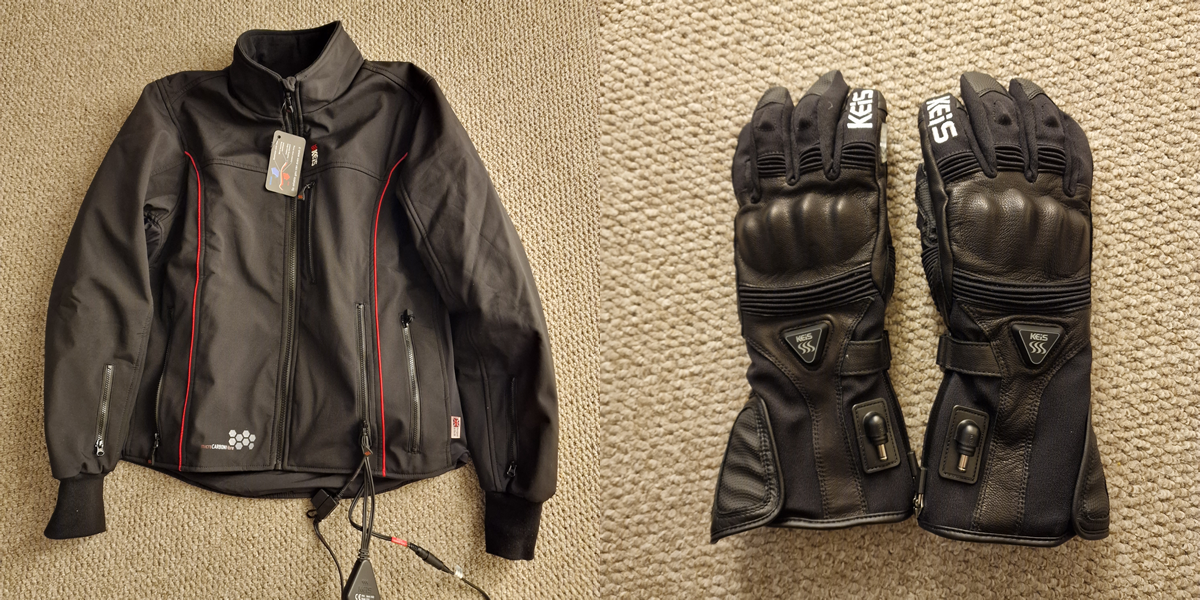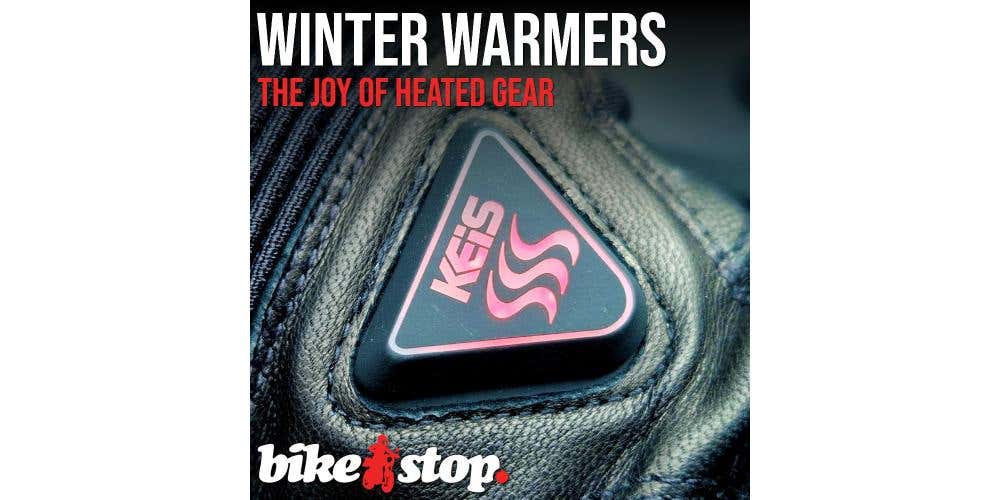I'm not allowed to swear in these blog posts. It's a shame, really. It makes it harder to describe precisely how cold it has been in the UK over the last week or so. However, if I describe the current weather as 'totally fridging freezing', you can probably figure out what I wanted to say. In my last blog, I wrote about the best ways to stay warm whilst riding throughout winter. However, despite layering properly with top-quality gear, the cold managed to penetrate my defences in a worryingly short time.
I only popped out for half an hour to refuel the bike in preparation for a long week of riding, but in that short amount of time, I realised my typical winter setup wasn't going to be enough. The ordinarily excellent heated grips fought a losing battle to keep my fingers alive. My arms, despite being wrapped in layers of Merino wool, goose down and Gore-Tex, became colder and more uncomfortable with every passing minute. In those precise moments, I knew I needed some heated gear.
The next day, I drove - yes, in a very warm car - to Bike Stop to check out the gear available from Keis. The original plan was to buy the Keis Heated Vest and possibly a pair of heated inner gloves. However, I ended up walking away with the J505RP Extreme Heated Jacket and G601 Touring Gloves. I went with the jacket over the vest simply because the memory of cold arms was still very fresh, and although I did try the inner gloves, I concluded they'd cost me a little too much in terms of dexterity over a standalone glove. I'm sure the inner gloves will work for some people, it just depends on your sizing and the type of gloves you use on top.
Being an overgrown and impatient child, I couldn't wait to get home to try out my new gear. So instead of exercising any kind of restraint, I decided to wear the jacket on the drive home and plugged it into the car's 12V accessory socket. I knew the jacket would be warm; the dozens of reviews I'd absorbed the night before made that perfectly clear. However, I didn't expect it to be that warm.
The wave of heat hit me immediately. I felt like I'd slipped into a deep, hot bath within seconds of turning on the heating elements via the three-stage control module. I was in heaven from my wrists to my shoulders and from my waist to my neck. How had it taken me so long to get on the heated gear train?
I switched it off after a few minutes, mainly because the car was starting to warm up, and I felt I was in danger of literally cooking myself. I couldn't wait to try out these new toys on the bike!


I returned home reasonably late in the evening, so my plan to go out for a quick test ride with my lovely new heated gear would have to wait until the next day. Sadly, this didn't go to plan. Unfortunately, after managing to avoid it for almost three years, I'd finally contracted COVID and spent the following week coughing, spluttering and feeling like I was constantly trying to swallow a cheesegrater. Unpleasant. However, after a week of suffering, a clear test, and feeling quite a bit perkier, I could finally go for a ride.
Firstly, I had to decide how to power my new gear. One of the most compelling reasons to go with Keis is that their gear works on a modular system. The gloves plug into the jacket, the trousers plug into the jacket, the insoles and socks plug into the trousers, and so on. The result is that you have a single power connection, which you can connect to the bike via its 12V accessory socket or connect directly to the bike's battery via the supplied wiring harness.
Initially, I thought I'd use the 12V accessory connection because accessing and connecting anything to the Africa Twin's battery is fiddly and unpleasant—thanks, Honda. However, I wasn't thrilled with the excess cable flapping away and figured I'd pay the blood sacrifice necessary to appease the gods of Honda and connect to the battery instead. It wasn't all that bad. After just forty-five minutes, seventeen episodes of swearing, and only bleeding from three different wounds on my hands, I had the harness wired to the battery and the power connection poking out from the front of the seat. I'm sure it's a more straightforward job on less irritating bikes. With everything hooked up and the bike telling me it was -2°c, it was time to ride and see how much of a difference the Keis gear makes.


I had some concerns about how bulky the Keis jacket would feel as it replaced the short, slender goose-down liner jacket of my Dainese Antartica. However, I needn't have worried. Although the Keis jacket is a bit thicker and a bit longer, it fits perfectly well underneath the big-boy Dainese jacket, and I could still zip it to the Tonale trousers without issue.
The only real concession I had to make was that I usually wear my gloves under the sleeves of my jacket, but the length and girth of the Keis gloves, in combination with the tight neoprene wrist closures of the Antartica made this a bit tricky. Consequently, it was easier to wear the gloves over the cuffs. I didn't consider this to be a major sacrifice.
I connected the jacket to the bike, started the engine, switched the jacket to its "High" setting and prepared to set off. It was at that moment I realised the jacket's controller module doesn't control the gloves. The gloves are controlled independently of the jacket, so a long push on each of the gloves buttons wakes them up.
The jacket has three heat modes; high, medium and low, and you can cycle through them with a prod of the controller module. The gloves also have the same three heat modes, and you can cycle through them with a press of the button. The button will glow red to indicate the highest heat setting, amber for medium and green for low. It's a great design and easy to operate with gloved hands. Furthermore, I found that tapping the button on the underside of my grips works well, too, which saves you from having to cross your arms to fiddle with the gloves whilst riding. Handy.
The jacket performs incredibly well. After fifteen minutes of riding, I had to knock it down from "high" to "medium" as I was starting to feel a little uncomfortable. I suspect this is the best way to use it; start off on high to get your core temperature up a bit and then drop it down to sustain that temperature. Everyone feels the cold in different ways, but I'm sure you'll be able to find something comfortable, even if you do end up changing the heat level every so often.
The gloves are a little different to the jacket. Although they don't appear to be capable of reaching the "uncomfortably hot" level of the jacket, they provide more than enough heat not to require the use of the heated grips. The heat is even and consistent throughout the glove, and I couldn't detect any cold spots whilst riding.
Additionally, they're excellent gloves in terms of fit, comfort and dexterity. I tend to have issues with glove sizing, either ending up with gloves too short in the fingers or too long in the thumbs. However, the Keis G601s fit perfectly, and I'd have happily paid the price without the heating elements—they're that good! They're not horribly bulky like some winter gloves, either. In fact, I don't feel like I'm losing much dexterity when compared to my summer gloves.
After an hour of riding I was very warm, very comfortable and very happy. I have never been able to ride with this degree of comfort during the winter months, and never when temperatures drop below zero. The gloves and jacket represent an investment of just over £400, and I know this isn't an insignificant amount of money. However, the plus side is that the bike is now a completely viable option for travelling during winter; I'm no longer worried about cripplingly cold fingers or shivering for half an hour at my destination. If the only thing holding you back from winter riding has been the thought of dealing with the cold, you need to explore heated clothing. Now that I've tried it, I know I can't live without it, and I'll probably be slightly annoyed when summer arrives.






